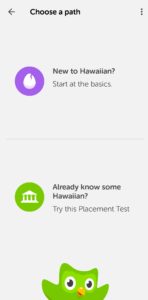By Ayoung Lee | Staff Writer
On Oct. 9, the language learning platform Duolingo started offering Hawaiian as one of its lessons. It offers difficulty levels for beginners who don’t know any Hawaiian, and those who already have some knowledge of the language can take a placement test that gets harder or easier based on your answers and figures our what level you are at. Users can also decide how many minutes a day they wish to spend studying: 5, 10, 15, or 20 minutes.

Choose how long you will practice each day. (Screenshot by Ayoung Lee)
Having never used Duolingo or learnt Hawaiian before, the system was easily accessible and simple to navigate. The website and application has a simple layout, which makes it easy to see where everything is. It also lets you study more than one language at a time for those who wish to challenge themselves more. With gentle reminders to come back to study you get less of an excuse to miss your lessons. The gentle reminders, however, come as push notifications and are easily dismissed on a busy schedule and forgotten at the end of a day. I found this to be my biggest failing with the application as I would lose my daily streaks and through the few weeks I used the service, I missed many days in a row. As anyone may know, the key to learning anything is repetition and daily practice so missing practice lessons for days due to forgetting or pushing it off as it isn’t a required class makes it hard to learn the language.
One thing to keep in mind is that if you choose the beginner level and find it too easy, there doesn’t seem to be a way to go back and take the test or speed through the lessons to get to a point more your speed. Knowing this, it may just be beneficial to start off taking the placement test and begin at a speed that will keep your interest. You get “lingots” for logging on continuously for 10 days, which you can use to buy “power ups” to help you gain experience points or clothes. I found that the lingots were harder to get than I thought and would have enjoyed more options for spending them. The lessons are simple and can seem repetitious but it works to help you memorize the vocabulary.

You can choose between not knowing Hawaiian or taking a test. (Screenshot by Ayoung Lee)
Once the lessons start, the format is simple and neat with Hawaiian on the top and English words on the bottom that you have to choose from that matches the Hawaiian. Some questions will include pictures and others will include pronunciation soundtracks. Should you ever get stuck on a word that you are not sure of, you can click on the Hawaiian word and it will tell you the English definitions. This was useful when I got stuck but occasionally, as Hawaiian and English grammar is different, by requesting the definition of one word it gives you the definition of two or even the whole translation of a small sentence.
Even if you get a question wrong, don’t worry, it will come back around before the end of that lesson so that you can have another shot at it. With every wrong answer they also always let you know what the correct answer was so that you can learn from your mistakes.

The definitions will show when you click on a word. (Screenshot by Ayoung Lee)
The beginner course is very good for anyone who, as is intended for, doesn’t know any Hawaiian, only knows a few words, or would just like to have a refresher. Lessons start off with single words such as “aloha” or “hello” that you translate from Hawaiian to English and back. Then the lesson moves on to translate simple sentences where the word “aloha” is used with names. Lessons go on in this pattern with other simple words for a while and only increase in level when you finish all the previous lessons. While I wish they would add games that could integrate the languages to make the lessons more fun this seems a very efficient way to learn quickly.
Invite friends to learn with you and you can compete with them on leaderboards. For those that feel like the mascot of Duolingo, the owl, that encourages you needs a bit of an outfit you can do your lessons and earn “lingots,” which you can use to buy your owl outfits. “Lingots” can be earned through leveling up, finishing a skill, 10-day streaks, and inviting friends.
Duolingo currently has 32 language courses available to English speakers with three more in the works. I would definitely recommend learning Hawaiian on Duolingo for anyone interested as it lets you go at your own speed and start at your own level. The rewards, while lacking in the application itself, shows from the lessons when you can pass the tests with ease. Those who do not do well with vocabulary and reading heavy learning compared to listen and repeat may not do so well with Duolingo.







Hey What we maintain here is , correctallocate
High-minded click
https://drive.google.com/file/d/1CLfEIv6SkvjIARA8HPd0lo1w0wN-X5Gd/preview